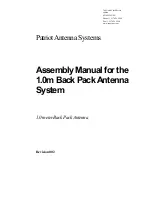
135
Cisco Aironet 6.5-dBi Diversity Patch Antenna (AIR-ANT2465P-R)
Installation Guidelines
7.
If any part of the antenna system should come in contact with a power line,
do not touch it or try to remove it
yourself. Call your local power company
. They will remove it safely.
8.
If an accident should occur with the power lines call for qualified emergency help immediately.
Installation Guidelines
Because the antenna transmits and receives radio signals, they are susceptible to RF obstructions and common sources
of interference that can reduce throughput and range of the device to which they are connected. Follow these guidelines
to ensure the best possible performance:
Mount the antenna to utilize its propagation characteristics. One way to do this is to orient the antenna vertically and
mount it as high as possible.
Keep the antenna away from metal obstructions such as heating and air-conditioning ducts, large ceiling trusses,
building superstructures, and major power cabling runs. If necessary, use a rigid conduit to lower the antenna away
from these obstructions.
The density of the materials used in the building construction determines the number of walls the signal must pass
through and still maintain adequate coverage. Consider the following before choosing the location to install your
antenna:
—
Paper and vinyl walls have very little affect on signal penetration.
—
Solid and pre-cast concrete walls limit signal penetration to one or two walls without degrading coverage.
—
Concrete and wood block walls limit signal penetration to three or four walls.
—
A signal can penetrate five or six walls constructed of drywall or wood.
—
A thick metal wall causes signals to reflect off, causing poor penetration.
—
A chain link fence or wire mesh spaced between 1 and 1 1/2 in. (2.5 and 3.8 cm) acts as a harmonic reflector
that blocks a 2.4-GHz radio signal.
Install the antenna away from microwave ovens and 2-GHz cordless phones. These products can cause signal
interference because they operate in the same frequency range as the device your antenna is connected to.
Install the antenna in a
vertical orientation to maximize signal propagation.
Site Selection
Before attempting to install your antenna, determine where you can best place the antenna for safety and performance.
Follow these steps to determine a safe distance from wires, power lines, and trees.
1.
Measure the height of your antenna.
2.
Add this length to the length of the structure on which you are mounting the antenna and then double this total for
the minimum recommended safe distance.
Caution:
If you are unable to maintain this safe distance, stop and get professional help.
Generally, the higher an antenna is above the ground, the better it performs. Good practice is to install your antenna about
5 to 10 foot (1.5 to 3 m) above the roof line and away from all power lines and obstructions. If possible, find a mounting
place directly above your wireless device so that the lead-in cable can be as short as possible.


























